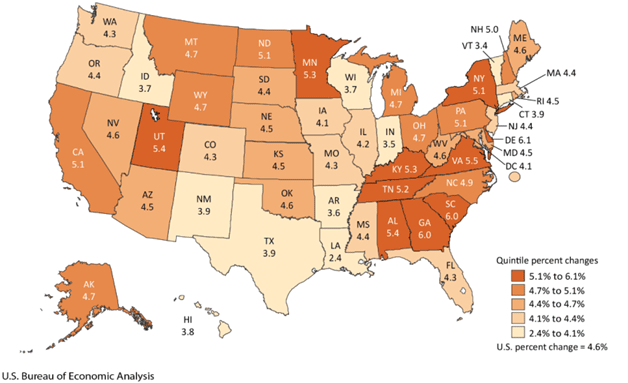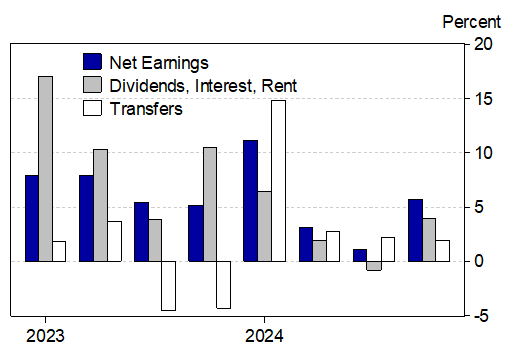Arizona’s Income Growth Downshifts
By George W. Hammond, EBRC director and Eller research professor
State per capita personal income was 89.0% of the U.S. last year
Arizona personal income rose 4.5% over the quarter to close out 2024 (seasonally-adjusted annual rate). That was slightly slower than the U.S. at 4.6% (Exhibit 1). That ranked Arizona 26th in the U.S. (excluding the District of Columbia). Personal income, before adjustment for inflation, rose the fastest in Delaware, followed by South Carolina, Georgia, Virginia, and Alabama. Personal income rose the slowest in Louisiana, Vermont, Indiana, Arkansas, and Idaho.
Exhibit 1: Personal Income Growth by U.S. State, 2024Q3 to 2024Q4, Seasonally-Adjusted Annual Rates
Net earnings from work rose 5.7% over the quarter in Arizona, compared to 5.1% nationally. Income from dividends, interest, and rent rose 3.9% (2.9% nationally) and transfer receipts rose 1.9% (5.0% nationally).
Of Arizona’s 4.5% growth in the fourth quarter, 3.3 percentage points came from net earnings; 0.8 percentage points from dividends, interest, and rent; and 0.4 percentage points from transfer receipts.
After starting the year strong, with a 10.9% increase in the first quarter, Arizona’s personal income gains slowed during the middle quarters (2.7% in the second and 0.9% in the third) before rebounding modestly to 4.5% in the fourth quarter.
Exhibit 2 shows the uneven nature of income growth last year, broken down by component. Note the strong start to 2024 in all components, particularly transfer receipts, followed by slower gains or even quarterly declines.
Exhibit 2: Arizona Personal Income Growth by Component, Over-the-Quarter, Seasonally-Adjusted Annual Rates

For 2024 as a whole, Arizona personal income rose 5.2% over the year, down from a 7.0% increase in 2023. That was also slightly below the national average of 5.4%. Keep in mind that data for 2024 will be revised later this year.
In Arizona, net earnings from work rose 5.9% over the year. That outpaced the U.S. at 5.5%. Dividends, interest, and rent increased 5.1% (4.0% nationally) and transfer receipts rose 3.2% (6.2% nationally).
For the year, net earnings contributed 3.4 percentage points of the state’s overall 5.2% increase. Dividends, interest, and rent contributed 1.0 percentage points and transfer receipts contributed 0.7 percentage points.
On an inflation-adjusted basis (using the Phoenix MSA All-Items CPIU), Arizona personal income rose 2.9% over the year in 2024, up from 1.8% in 2023. Arizona outpaced the U.S. in 2024, with national growth at 2.3%. Arizona’s real income acceleration in 2024 was entirely driven by slower Phoenix inflation, which slowed from 5.1% over the year in 2023 to 2.2% in 2024.
In 2024, the District of Columbia had the highest per capita personal income among states, at $108,233, followed by Massachusetts, Connecticut, Wyoming, and New York. At the other end of the spectrum, Mississippi had the lowest per capita personal income ($52,017), followed by West Virginia, Alabama, Kentucky, and New Mexico (Exhibit 3).
Exhibit 3: Per Capita Personal Income by U.S. State, 2024, Dollars
Arizona’s per capita personal income hit $64,456 in 2024. That was well below the national average of $72,425. In particular, Arizona’s per capita personal income was 89.0% of the national average in 2024, down from 89.6% in 2023, and ranking 36th in the nation (including the District of Columbia).
At 3.6%, Arizona’s growth fell short of the U.S. average in 2024 (4.3%), and decelerated from a 5.6% increase in 2023. Arizona’s nominal growth was modestly above the Phoenix rate of inflation in 2024 (at 2.2%), generating an inflation-adjusted increase of 1.4%. That was slightly above the U.S. at 1.3%.





